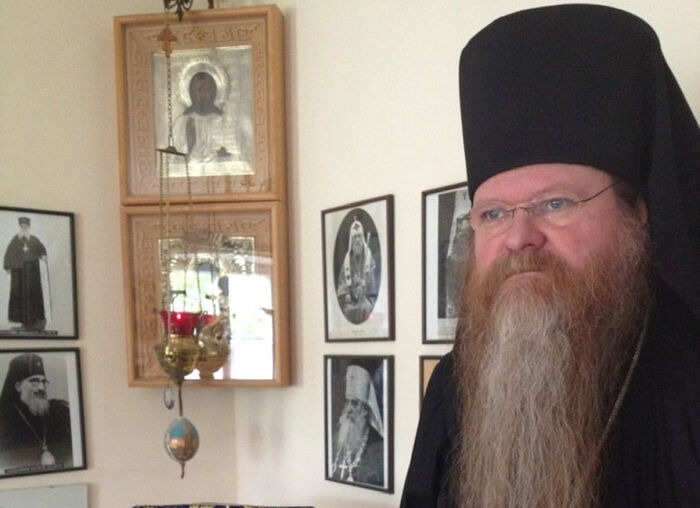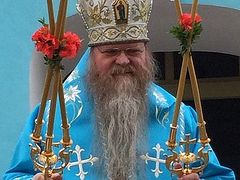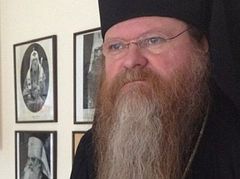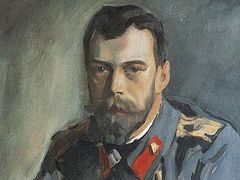Not long ago was the fortieth day after the repose of Archbishop Agapit (Gorachek) of Stuttgart (ROCOR). More and more reminiscences about this remarkable man have been sent to the Russian website Pravoslavie.ru and continue to come; that is what an indelible impression this bright personality has left in the hearts of those who knew him.
This is a story of Archbishop Agapit, but through him of the “Ekaterinburg remains”—bone fragments discovered in a gully outside Ekaterinburg, which recent investigations have shown with near certainty to be those of the Royal Family. These investigations were conducted for over ten years on the highest level. They encompassed all aspects of forensic science, including genetic testing in a number of laboratories. It is told by one of the main investigators, who through his work gained a personal understanding of Archbishop Agapit’s close connection with the Holy Royal Martyrs and his service to them in this important matter.
On the eve of the feast of the Ascension of the Lord, Archbishop Agapit (Gorachek) of Stuttgart, a vicariate of the Berlin and Germany diocese of the Russian Orthodox Church Outside of Russia (ROCOR), departed to eternity.
This man’s whole life was mystically connected with the fate of the last Russian Emperor, Nicholas II and his family, whose sincere and dedicated venerator Vladyka always was. He had a profound knowledge of the life and sufferings of the Royal Passion-Bearers—not only the history of their last days while imprisoned in Ekaterinburg, but also the chronicle of their murder by the Bolsheviks, the attempts to hide and destroy their bodies, and the secret burial of the royal remains.
Vladyka was the only bishop who in the year 2008 supported and blessed the publication of the book by N. L. Rosanov, written as an apology for the remains of the Royal Family. The author presented the manuscripts for the book, archival documents, photographs and other materials to Vladyka Agapit and openly shared her research with him. After the book was released it was sent to practically the entire Orthodox episcopate, to many clergymen and laypeople, along with the letters of Vladyka Agapit, who in this way became the first apostle of the Royal relics.
I was periodically officially involved in the forensic investigation of the circumstances surrounding the death of the Russian Imperial House, from 1993 to 2015 (in 1991–1993, before the opening of a criminal case, I directed the verification of documentation on the discovery of the remains). As a person who had for many years studied the history of the Royal Family’s death, I had the good fortune to spend time with Vladyka Agapit. Certain episodes in his life were personally known to me, while others I learned from our shared acquaintances. Many amazing facts about the now reposed archbishop’s activities are still in the shadows. Therefore today I would like to reminisce about how Vladyka Agapit served the memory and glorification of the Royal Family during his lifetime.
He firmly believed that he was born on this earth thanks to the heavenly patronage of Empress Alexandra Feodorovna, and he always particularly honored her. Vladyka saw the spiritual connection between his own family and the Royal family in the Empress’s miraculous intercession for his parents during the days of their youth and love. He spoke of his family’s, his mother’s heritage in the following story:
“In 1981, on July 17, on the commemoration day of the murder of the Royal Family, my father died. That this repose day was internally connected with the Royal family was revealed to me only later.
“I occasionally visited my widowed mother. One day she told me how she met my father in the camp for political refugees from Russia, the so-called “DPs” (displaced persons), and what troubles fell to their lot. This was in the village of Menchehof near the city of Kassel in Western Germany in the late 1940s. My father fell deeply in love with my mother. But the two were threatened with separation. My mother’s parents were preparing to emigrate to America, and in no way did they want to leave their only daughter in the ruins of Germany. No tears, nothing could persuade them otherwise. My father was desperate. Mother was torn apart. It was nearly the eve of their departure to America on the steamship when my mother had a vision in a dream. The Tsaritsa-Martyr Alexandra Feodornovna appeared to her and said, “You must stay in Germany!”
In the morning, mother told her father about the dream. My grandfather—my mother’s father—had served under the Tsar in His Excellency’s battalion. Giants from all over Russia were gathered into it; they had to be over two meters tall. My grandfather was the shortest man in that battalion. Therefore he marched in the very last row, in the right flank. Because he possessed a beautiful tenor voice, he served as headman in that battalion. They say that it was a dazzling spectacle when these parade battalions walked along the streets and sang Russian army songs…
“When he heard from his daughter about the appearance of the Tsaritsa, my grandfather fell silent and then uttered, ‘Well, if that’s so, then we must obey!’ And so my mother’s parents left for America without their daughter.”1
Vladyka was born in Frankfurt-am-Maine in 1955. He grew up literally “in the parish”, was brought into church life from infancy, and from age seven was already serving in the altar of the Church of Christ the Savior. A portrait of Emperor Nicholas Alexandrovich hung in the Gorachek home—a black and white copy of the work by Valentin Serov.
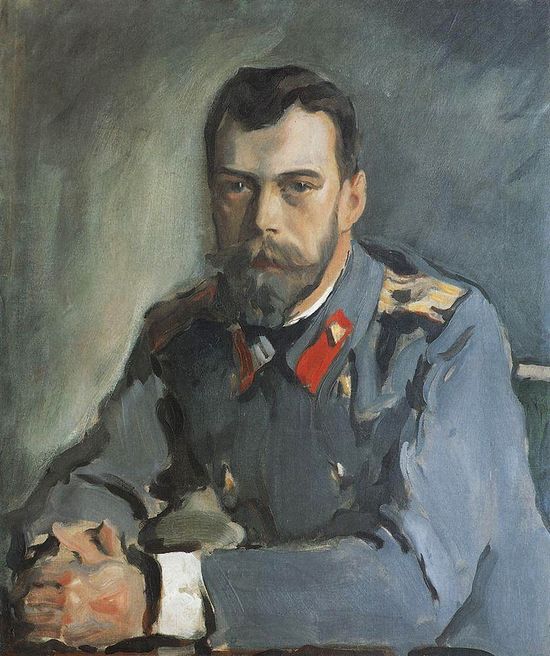 Portrait of Tsar Nicholas II by Valentin Serov.
Portrait of Tsar Nicholas II by Valentin Serov.
“We rarely talked about the Royal Family,” Vladyka recalled. We mainly discussed the possibility of restoring the monarchy in Russia, about which my father himself had his doubts, because he understood that the times had changed and there was no longer any spiritual ground ready for this.”2
Vladyka’s father published the periodical, Posev, and was also an active member of the NTS.3 The future archbishop also participated in this movement, and helped his father typeset the well-known magazine.
In his youth, out of his love for architecture Vladyka became a student at the architectural department in Darmstadt. But at one moment—his inherent yearning to fathom the depths of everything made itself known—he decided to study history, political science, and philosophy in his hometown university of Frankfurt-am-Main. However his studies did not satisfy his inner search, apparently because he was an independent thinker with an inquisitive, free mind.
In 1978, Vladyka travelled to Toronto as a member of a delegation from the diocese of Germany to the All-Abroad Assembly of Russian Youth, and after it closed he went to visit the Holy Trinity Monastery in Jordanville, one of the spiritual centers of the emigration. Here he had a meeting that would prove memorable and significant for his whole life.
“After the feast,” he related, “the current abbot, our [at the time of this citation.—Ed.] First Hierarch Metropolitan Laurus called me to himself and handed me the protocols of the investigative case by Nicholai Sokolov concerning the murder of the Royal Family. This was a copy that General Dieterich had made for himself when he was commander of the military region in Ekaterinburg, where an investigation was being conducted under the direction of Nicholai Sokolov.
“I was entrusted with taking the protocols to Frankfurt. The Holy Trinity Monastery had rejected the publication of it due to their lack of an in-house scholar competent to work through such a document. Subsequently the Posev publishing house (which I participated in, because my father was the officially responsible publisher4) published these protocols under the title, The Murder of the Royal Family”. All the materials were edited with commentary by the historian Nicholas Ross.
“I remember how stirred I was about all of this when I saw the photographs of the murder site, when I read the blood-curdling testimony of witnesses, etc.”5
During that trip, at the All-Abroad assembly, Vladyka made his final decision about his path in life, later joking that he had gone to America to find a bride, but in the end chose monastic life.
In early 2004, Vladyka Agapit wanted to spend time in Russia, and dreamed of visiting the Russian Golgotha—Ekaterinburg. Having arrived by airplane to the capital of the Urals, Vladyka shared his travel impressions with those who came to meet him and noted:
“In the airplane we found an article on the Ipatiev House; the Royal theme is travelling with us, and this is our main reason for coming!”
When he first stepped upon the territory of the “Ganina Yama” monastery, a curious but quite telling meeting took place. One young man, having spotted the well-known bishop, went up to Vladyka Agapit for a blessing and asked, “Vladyka, where are you from?”
“We’re from far away,” I said in avoidance.
“But really, where are you from?” the young man said unperturbed.
“We’re from Germany.”
“Is that where Mt. Athos is?”
“No,” Vladyka replied seriously and without the slightest hint of a smile, “We don’t yet have an Athos in Germany…”
Characteristic of Bishop Agapit was his unfeigned respect for every person, his ability to relate to all as individuals, as a father. It was plain that the bishop received this unexpected and funny question about Mt. Athos in Germany sincerely and not as a joke. Perhaps it is because the Monastery of St. Job of Pochaev, where he was a monastic from 1980 on, truly was considered the “Athos of Munich”; it had an Athonite coenobitic rule and had inherited Athonite traditions. Vladyka Agapit, like its abbot Archbishop [now Metropolitan] Mark (Arndt), had visited Mt. Athos many times over the course of several years and spent much time with the hagiorites. At the same time, his words to this young Russian man who had happened along were testimony to his monastic modesty.
In Ekaterinburg, Archbishop Agapit first learned the historical facts about the secret burial of the Royal remains and their discovery in 1979 by a group of enthusiasts, G. T. Ryabov and A. N. Avdonin. He was stunned, as he said, at the discovery that had “crashed down upon him” and which completely changed his view of the “Ekaterinburg remains”, as well as to the place where they were found. During his brief stay in the Urals, from April 17–24, Vladyka visited Piglet Gully [where the remains were found], prayed at the place of the Ipatiev House prisoners’ secret burial, and took many photographs. He was an avid amateur photographer took his camera everywhere on the trip.
During his first trip to Russia, Archbishop Agapit met with Natalia Roznova, the future author of the book on the Royal remains, when heated polemic was going on concerning their authenticity. The manuscript of the book, which was originally named, “At the Threshold of the Grave”, the author gave a copy through her acquaintances to Metropolitan Laurus of Eastern America and New York in hopes that he would support its publication. When Archbishop Agapit heard about this, he apparently guessed what the reaction would be and encouragingly said to the author:
“Don’t worry, if they reject it, all the more glory for us!”
Truly, despite the good inclinations of the First Hierarch of ROCOR, who welcomed the necessity of research into the subject of the murder of the Royal Family, he decided not to get involved in the study of the “Ekaterinburg remains” issue, considering that “the time had not yet come”. It was then that Archbishop Agapit resolved to support the book and its researcher himself.
Beginning from 2004, Vladyka made every attempt to get the higher clergy interested and attract their attention to the study of this matter and the recognition of the Royal remains. Natalia Rosanova did much to help the archbishop in determining his own position on the issue. She acquainted him thoroughly with the investigation documents and the forensic research. Natalia Rosanova’s book, The Royal Passion Bearers. Their Posthumous Fate, published in 2008, and which is to date probably the best publication amongst many publications dedicated to the “Ekaterinburg remains”. Archbishop Agapit also put no little effort into learning more deeply about the history of the burial, and he had the courage and faith to write in the prologue to it:
“This book can give an answer to the question of the authenticity of the remains found in Piglet Gully and on the Koptyakov road, and shed light on the history of this terrible and evil deed.”6
In October of 2004, Vladyka Agapit again flew to Ekaterinburg, bringing with him a group of eighteen pilgrims—the priest and parishioners of the Church of St. Nicholas in Darmstadt. The pilgrims from Germany acquainted themselves thoroughly with the history and all the facts surrounded the murder of the Royal Family and the Romanovs in the Urals, taking the full route of the Royal road.7 They prayed also at the railroad tie bridge in Piglet Gully, where the bodies of those murdered in the Ipatiev house were hidden. It can be said without exaggeration that representatives of Russian Church Abroad were the first Orthodox to venerate and pray at the Royal Family’s burial site. When the pilgrims returned home, they published a report with photographs of their travels in the periodical, Journal of the German Diocese of ROCOR.8
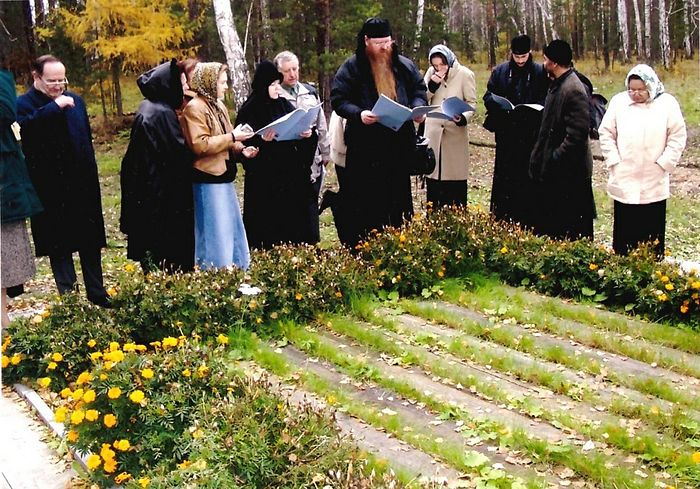 Vladyka Agapit with pilgrims from Germany at the railroad tie bridge. Reading the service to the Royal Passion Bearers. October, 2004.
Vladyka Agapit with pilgrims from Germany at the railroad tie bridge. Reading the service to the Royal Passion Bearers. October, 2004.
Several years before the historical reunification of the Russian Churches, a pilgrimage group, with the blessing of their local bishop, received Communion in churches of the Moscow Patriarchate. This showed the position of Vladyka Agapit, who was a fervent and systematic supporter of the reunification. The Monastery of St. Job of Pochaev in Munchen, were he was a resident monk, was one of the places where the “Act of Canonical Union of ROCOR and the ROC” was drafted. There were also meetings conducted for dialogue between the commissions of ROCOR and the Moscow Patriarchate.
On May 17, 2007, in the Christ the Savior Cathedral in Moscow, Metropolitan Laurus of Eastern America and New York and Patriarch Alexiy II of Moscow signed the historical document of canonical communion between ROCOR and the ROC. And in that same year, a significant and conclusive event in the history of the Royal family’s murder took place.
Many remember His Holiness Patriarch Alexiy’s statement to the President of the Russian Federation and the General Prosecutor of Russia, wherein in 1995 he put forth the famous ten questions, which if left unanswered, the Church would refuse to recognize the Royal remains as authentic. The prosecutor answered nine out of the ten questions, but question no. 7—“Clarification of the fate of the remains of Alexis and his sister”—remained unanswered. Over the span of more than ten year, attempts to find their remains had been unsuccessful. The last excavations, organized in 2004 by the Moscow medical forensics expert Sergei Nikitin, stopped sixty meters from the true place of burial. To be honest, the prosecutor’s office had no intention of continuing the search.
Having studied a heap of historical materials, and having conducted enormous analytic work, the Ural trackers Leonid Vokhmyakov, Nicholai Neumin, Vitaly Shitov, and Andrei Grigoriev found the burial site of the Royal children. It was discovered and opened on July 29, 2007.
In August of that year, in the Russian General Prosecutor’s office where I was working as a prosecutor-criminologist, important structural changes were taking place. The organization changed, and within it was formed the Investigative Committee, headed by A. I. Bastrikin.9 All of the colleagues involved in the investigation were formally let go, and the Investigative Committee staff was formed anew. I did not view the prospects of working in the new sub-department of the General Prosecution as something very rosy. It was during those days, when the continuation of my service was hanging in the air, I received a call from Ekaterinburg. The message stunned me. Seventy meters from the burial site of the members of the Royal Family were found certain half-burned remains, which could belong to the Tsarevich Alexis Nicholaevich and Grand Duchess Maria Nicholaevna.
The people in the Urals kept the discovery secret. My attempts to ascertain at least some details by telephone ended in nothing. I had to go to the locality. I am grateful to A. I. Bastrikin for trusting me and giving me the opportunity to continue my work on the “Ekaterinburg remains”. On August 17, 2007, fragments of the remains were transferred to the Bureau of judicial-medical expertise, and on August 21, after my report to A. I. Bastrikin, the Russian General Prosecution renewed its investigation into the criminal case. I will not describe all the complications with which we had to deal; we were able to overcome them. At first it was not clear whether we would be able to successfully conduct an identification of the remains. Truly, the small bone fragments had lain in the earth for nearly ninety years. The bodies had been burned, and drenched in sulfuric acid. Only late in 2007, when geneticist Evgeny Ivanovich Rogaev reported that organic matter was preserved in the bone and tooth fragments, did any hope arise in a successful genetic investigation
It was good to know that this time, the excavations were conducted with the participation of Church representatives, who scrupulously recorded everything in videos and a mass of photographs. Moreover, Bishop Agapit (Gorachek) quite unexpectedly came to the Urals in August of 2007. As soon as Vladyka heard about the discovery of the remains of the Royal children (even before it officially made the news) he straightway flew to Ekaterinburg. He decided to come to the locality to sort out and acquaint himself with the history of this find himself. In 2007 I was unable to meet with the bishop, but they told me how attentively he delved into studying the circumstances and documents on the discovery of the bone remains, and discussed it with practically all the specialists connected with the search and primary investigation.
He spent time in the office of N. I. Nevolin, head of the bureau of judicial-medical expertise in Sverdlovsk province, where he held the discovered relics of the Royal children in his hands. The bishop again visited Piglet Gully and there met and spent much time with the searchers from the military-historical club, “Mountain Shield”, as well as the original discoverer of the Royal family’s burial site, A. N. Avdonin. At the time, excavation work was ongoing. Ceramic shards of thick-walled jars used to contain sulfuric acid were unearthed. The Bolsheviks had used these jars, and the excavators showed them to Vladyka.
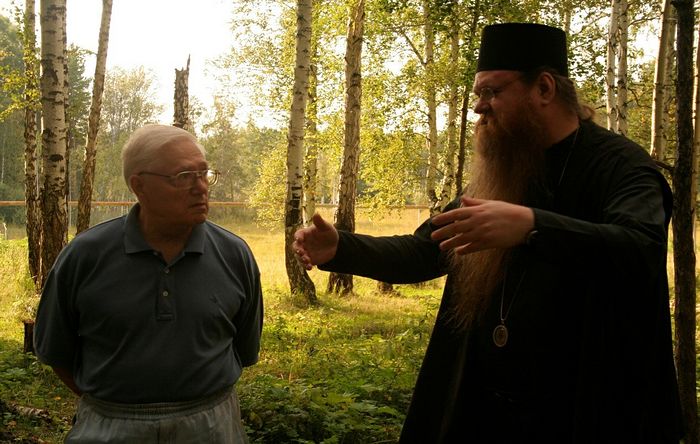 A discussion between Vladyka Agapit and A. N. Avdonin. Piglet Gully, August 21, 2007.
A discussion between Vladyka Agapit and A. N. Avdonin. Piglet Gully, August 21, 2007.
Vladyka Agapit was a Russian patriot and related to Russian people with great love, especially the simple folk. He never wanted to be spiritually separated from his brothers in Russia, and after inquiring about their names he would always commemorate the excavators and researchers of the Royal remains at the proskimedia, or pray for them in his cell.
He always remembered his meeting with the excavators as a gift from above, and often said that he was “thankful to God for this meeting” on the Koptyakov road:
“For me personally, my meeting last summer at Piglet Gully with the people who had uncovered the remains of Tsarevich Alexis and Grand Duchess Maria Nicholaevna was a bright event. The Lord granted that Russian people find each other at His holy place.”10
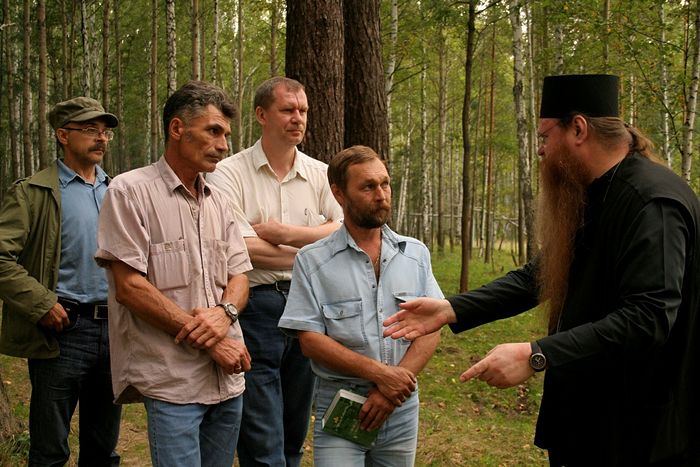 Meeting of Bishop Agapit with the searchers of the military-historical club, “Mountain Shield”. Left to right: L. G. Vokhmyakov, S. N. Malinnikov, N. B. Neiumin, S. O. Plotnikov. August 21, 2007.
Meeting of Bishop Agapit with the searchers of the military-historical club, “Mountain Shield”. Left to right: L. G. Vokhmyakov, S. N. Malinnikov, N. B. Neiumin, S. O. Plotnikov. August 21, 2007.
After returning from Russia, Vladyka flew to the U.S. for the ROCOR Synod meeting, where he presented his report on the discovery near Ekaterinburg of the place with the Royal children’s remains were hidden. As always he had his camera with him the whole way, and so he attached his photographs to his reports in America and Western Europe. Bishop Agapit’s attempt to independently sort out the problem of the remains undoubtedly influenced the hierarchs and clergy of the ROCOR.
In February 2008, Vladyka Agapit again visited Ekaterinburg. He was invited to the international Orthodox conference entitled, “The family and the future of Russia”, where he gave a report, the theme of which was the Royal Family. He knew that an investigation of the remains was being conducted and he was waiting for its completion, about which he openly reported at the conference. His view of the problem concerning the “Ekaterinburg remains” was that church society has yet to ripen in order to accept them as holy relics. It must be recognized that Archbishop Agapit’s position of ten years ago remains relevant today:
“The Russian Church has glorified the Royal Family, the Russian Church prays to the Royal Family (a testimony to this being the icons of the Royal Martyrs hanging in prominent places in our churches), but we are not yet worthy to venerate their holy relics.
“To this day it is still unclear where the path of dishonor ends in connection with the martyrs’ remains—does it end at Ganina Yama or at Piglet Gully? We hope that perhaps this year, with God’s help, this question will be answered…
“And I am sure that according to the measure of our spiritual growth and our ability to fathom the stand and podvig of the Royal family, we will be vouchsafed, at the right time, to venerate the holy relics of the Royal Passion Bearers.
“Let us together pour out our prayers, so that the holy Royal family would give the Russian Church and the Russian people final peace and clarity on the long road to our maturity and consciousness of their sanctity!”11
On December 5, 2008, at the international conference in Ekaterinburg, the results of the investigation of the remains of Tsarevich Alexis Nicholaevich and Grand Duchess Maria were made known. At the same time, the authenticity of the remains found on the Old Koptyakov road in 1998 was confirmed with a high degree of reliability. It is a great pity that His Holiness Patriarch Alexiy II died that same day; it was at his initiative that the question of investigation of the “Ekaterinburg remains” was posed at the governmental level.
Vladyka Agapit always looked for an opportunity to learn and explain something new for himself in the history of the investigation into the Royal Family’s murder. Thus, in 2008 he made the acquaintance of the grandson of Lieutenant General M. K. Diterich, Andrei Anatolievich, and studied his archive. And in 2012, at his insistence his spiritual children found and visited in Salbri, France the grave of the researcher N. A. Sokolov in order to serve a pannikhida there.
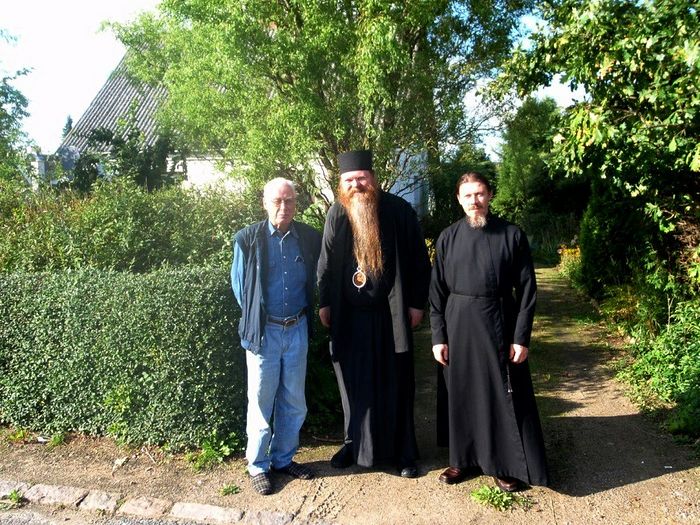 Vladyka with the descendant of Lieutenant General M. K. Diterich (far left), 2008.
Vladyka with the descendant of Lieutenant General M. K. Diterich (far left), 2008.
He did not remain indifferent to anything having to do with historical truth. In 2000 in Ekaterinburg a struggle ensued around the land belonging to the “Romanov Memorial”. There were plans to establish a cemetery on the territory of Piglet Gully, where the remains of the Royal Family had been hidden. Vladyka Agapit fully sided with the defenders of this historical place, and even took his own measures to preserve it.
In November 2008 in New Jersey, in the town of Red Bank, there was the first cross procession with the relics of the Royal Martyrs. They were kept in the local Orthodox Church of St. Nicholas, belonging to ROCOR. Particles of the relics had ended up in the church after the completion of genetic research in U.S. laboratories. Archbishop Agapit took the initiative and was able to ensure that fragments of the Royal Family’s remains be transferred to Western Europe, to the old church in the city of Stuttgart, where he was the rector.
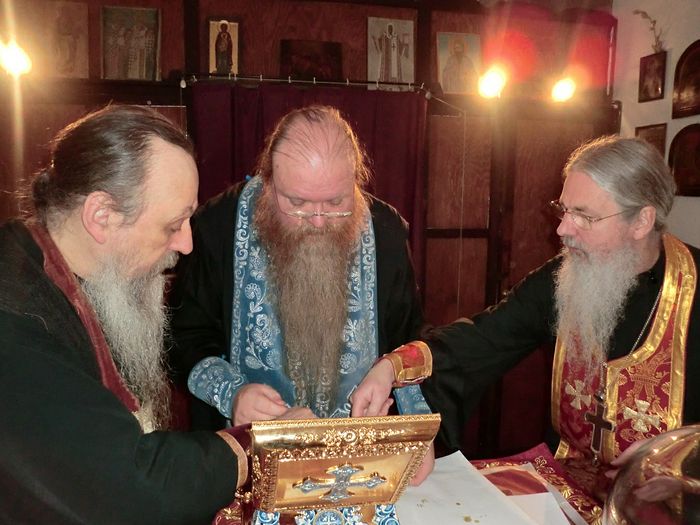 Preparing a reliquary with the relics of the Royal Family in the altar of the Cathedral of the Holy New Martyrs and Confessor of Russia and St. Nicholas the Wonderworker in Munchen. December, 2010.
Preparing a reliquary with the relics of the Royal Family in the altar of the Cathedral of the Holy New Martyrs and Confessor of Russia and St. Nicholas the Wonderworker in Munchen. December, 2010.
In the history of the investigation of the Royal remains, Vladyka’s and my paths ran very close to each other, and one day they finally crossed. Vladyka Agapit, as I was later told, had a strong desire to meet me and spend more time with those who had already been involved in the case for many years, about whose activities he had already heard many times but whom he had not yet met. So, when he arrived once again in Moscow, the bishop met and became acquainted with the man who discovered the burial site, Geliy Trophimovich Ryabov,12 and also with me.
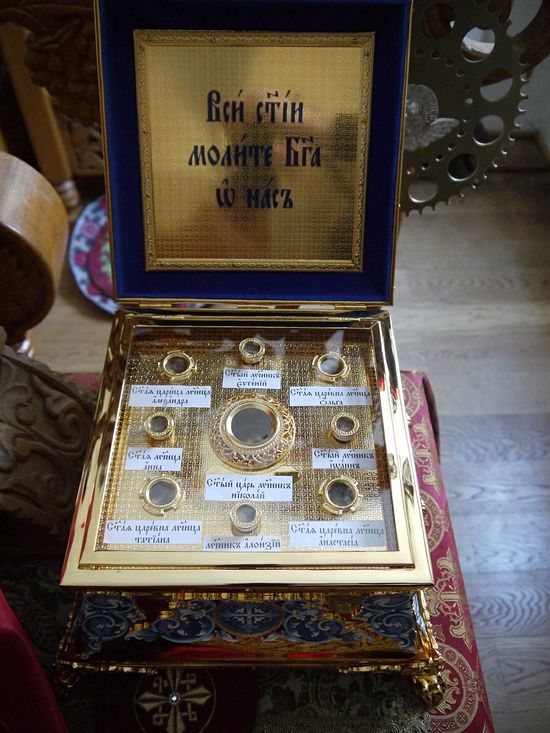 The temporary reliquary with the Royal relics.
The temporary reliquary with the Royal relics.
On Monday, November 16, 2009, the phone rang in my office. The caller introduced himself as “Bishop Agapit”. His speech was unusual—the first wave emigrants and their children have a particular Russian language, what has long been lost in Russia. We met that evening in a tiny church in the Zamoscvarechie district of Moscow. The bishop was of an unusual appearance: two meters tall, thin, broad-faced, with a long, bright red beard that reached his belt. He had a sincere face and a pleasant smile, which inclined one toward talking with him. We were brought some tea and pirozhki or bagels. We talked for nearly five hours.
I asked Vladyka how as a Czech he spoke such good Russian. He laughed good-naturedly at my question. “Of course I could be called a Czech because my grandfather was a true Czech from Prague. But a long time before the revolution he had entered St. Petersburg University, where he fell in love with my Russian grandmother and then worked for a long time on the railroad as far away as Archangelsk governate. So Russian is my native language, and in my soul I have always felt Russian.”
It was pleasant for me to see that Bishop Agapit was well acquainted with the subject of the Royal Family. Our conversation was not vague and rambling but perfectly concrete.
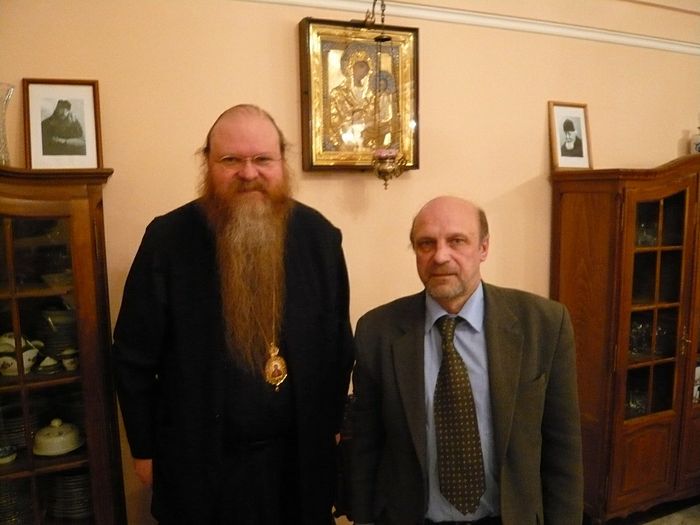 Meeting with criminal investigator V. N. Soloviev. November 16, 2009.
Meeting with criminal investigator V. N. Soloviev. November 16, 2009.
In 2004, Vladyka Agapit served temporarily in the Brussels cathedral and at the same time thoroughly studied the archive in the memorial church dedicated to Righteous Job the Longsuffering, built in memory of Emperor Nicholas II. I was always interested in finding an answer to the question of whether the Brussels church contained Empress Alexandra Feodorovna’s famous blue case containing fragments of the “bones” found by researcher N. A. Sokolov near Ganina Yama in 1919. The Bishop assured me that the case was never in that church, and of the “Sokolov” material evidence there remain only fragments of uninvestigated “fatty tissue” excavated from the mineshaft at mine no. 7. During his lifetime Sokolov never gave anything for safekeeping to any church, and left no such will and testament.
Vladyka took pictures of documents from the archives belonging to the Kotlyarovskys, who built the memorial church and given to N. Rozanov, who related to me how the bishop told the story of his research in Brussels:
“As the overseer at one time of the northern deanery of the Western European diocese, I often served in the memorial church in Brussels. I would stay at the home of Countess Maria Nicholaevna Apraksina, nee Kotlyarovskaya, whose family built the memorial church.
“Maria Nicholaevna confirmed unequivocally that the bone remains are not kept in the church. She showed me documents showing clearly that there can only be talk of the fatty material found by Sokolov in Ganina Yama. There are three glass jars in the church containing fatty tissue. Two were received from Prince Shirinsky-Shikhmatov from Paris (Met. Seraphim was the intermediary). The third was received from the Bulygin inheritance...13
“It must be mentioned that Nicholai Sokolov never gave these fatty materials for analysis to any laboratory, neither in Russia nor abroad.”14
The version that the Empress’s blue reticule and a series of other material evidence from Sokolov’s case were immured in the walls of the church’s altar has never been proven.15 I gave Bishop Agapit a copy of all the main documents. He advised me to address the head of the Church Abroad, Metropolitan Hilarion. I followed Bishop Agapit’s advice and prepared documents for Metropolitan Hilarion, and later I met with him.
Beginning in 2012, there were three exhibitions organized in Russia entitled, “The Murder of the Family of Nicholas II. An investigation that lasted a century”. The largest Russian archives were united in the person of the organizers, along with representatives from the ROCOR, the Holy Trinity Seminary, and the Russian History Foundation from Jordanville, New York. The representatives of the Holy Trinity Seminary together with Russian historians were the authors and coordinators of the exhibitions, writing articles for it. By that time they already had other experience of joint exhibitions in Russia.
In the archive of the Holy Trinity Seminary and in its museum in Jordanville, unique materials were preserved: the investigative case of N. A. Sokolov, and memorabilia and things belonging to the Royal family that were brought out of Russia by researchers to Western Europe and later given to the Russian Church Abroad by Grand Duchess Xenia Alexandrovna for safekeeping. Many unique expositions, documents, and possessions of the Royal family were first displayed at exhibitions in Russia by the Holy Trinity Monastery and Seminary, were they were kept.
At the opening of the first exhibition, which took place in 2012 in Moscow at the State Archives of the Russian Federation, was the First Hierarch of the Russian Orthodox Church, Metropolitan Hilarion of Eastern America and New York. And when in July 2013 a similar exhibition was conducted in Ekaterinburg, Vladyka Agapit came to its opening. This was his last visit to the Urals...
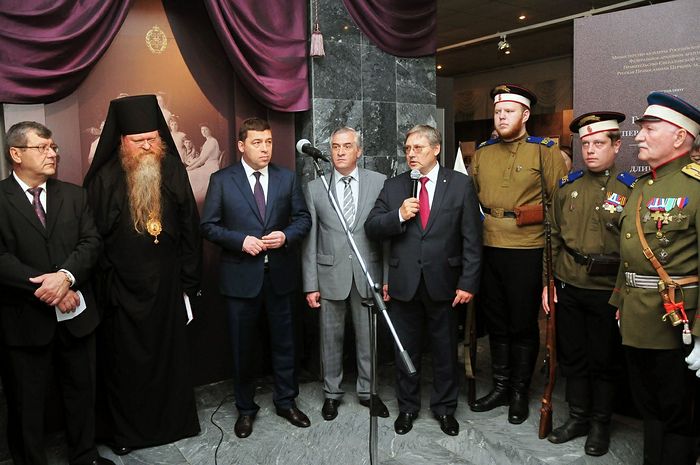 Bishop Agapit at the Exhibition opening. Ekaterinburg, July 11, 2013.
Bishop Agapit at the Exhibition opening. Ekaterinburg, July 11, 2013.
In 2015, a criminal investigation was reopened. The question of the burial was officially resolved, and the date was set. We could have proceeded according to the old scenario of the 1990s and simply buried the remains, so that they would rest in peace. But I wanted to correct the impossible; I wanted that the representatives of the Church would finally see and be convinced themselves that these truly are the holy relics. My meeting with Fr. Vsevolod Chaplin completely turned back this process. He stated the conditions under which the Church representatives would be able to reconsider their position. I agreed, at the time still naively believing that with the help of historical truth and conscientious expertise, something could be proved to the doubting. Our relationship did not come together, a new investigator was appointed, and despite the multitude of dishonest information addressed at me, despite the claims against the quality of my work, the new investigation led to the same conclusions as mine. Genetic analysis conducted by independent experts assigned by Church hierarchs completely confirmed that the remains belonged to the Royal Romanov family.
The results of the genetic investigations allowed for a more open discussion of the matter in the Church community concerning the authenticity of the “Ekaterinburg remains”. In November of 2017 in Moscow, within the walls of the Sretensky Seminary, an Orthodox conference was held to which Archbishop Agapit was invited. He observed the discussion with great interest, and when the question arose as to why no miracles have occurred from them, he asked with surprise, “You are expecting miracles? Can miracles be expected by such a militant opposition?”16 It was obvious to him that an experience of grace in impossible without faith. It was the bishop’s thought that precisely the canonization of the Royal Family [by the Moscow Patriarchate] became the mystical cause for the reunification of the two parts of the Russian Church, and he viewed the long drawn-out polemic of many years about the “Ekaterinburg remains” as a strange “spiritual phenomenon”. “We, outside of Russia, do not doubt the Royal remains, but in Russia there is doubt and people have not recognized them. The researcher Sokolov’s version is outdated, but they refuse to let go of it...”
At the conference Vladyka Agapit was allowed to give a word of introduction in which he presented the position of the ROCOR hierarchs regarding the Royal remains. It was impossible to imagine at the time that the archbishop’s speech, which was heard throughout the Orthodox world, would be his swan song:
“In the 1990s there was such unsettled discussion in Russian society, and this particularly had to do with the investigation of the first burial, in 1991. And the way that the newspapers presented it was for us abroad just terrible—simply to the measure that it was presented in the newspapers, etc. That is why we didn’t take much part in it.
“In 2000, the situation began to change. And I for example can relate from my own experience. In the 2000s I travelled to Ekaterinburg and began going to Koptyakov road to look and acquaint myself with the local historians who participated in the first burial site. Then in 2007 I was hospitalized in Peredelkino [a suburb of Moscow], where there is a cardiology hospital, and I was being treated there. I got a phone call: “Vladyka, come to Ekaterinburg, they’ve found the second burial site.” I caught a plane without delay, flew to Ekaterinburg, and met the searchers, including Leonid Vokhmyakov who intuitively dug into this pit and noticed a piece of bone. I can speak for myself. Other hierarchs of the Church Abroad have had similar impressions, made analogous experiments. And we had a Synod meeting in New York, where the Metropolitan asked a blessing from the Synod, those hierarchs who had received particles of those relics: Do we have the right to venerate them? And the Synod blessed this!17 As you know, we had an investigation of them in Washington, in the Pentagon, and that is how these particles found their way abroad. The Metropolitan also had the particles his possession, and he was asking the opinion of the Synod.
“I can say that simply with the presence of the investigations that are currently being conducted, we have no doubts. A large portion of the Hierarchs of the Church Abroad do not doubt and have no reason to doubt those investigations completed in the 1990s, as well as in 2007; and what is most joyful, in the last two years the Church has directly taken part in the investigations.”18
Archbishop Agapit’s approach to the question of the “Ekaterinburg remains” could be set forth as an example of a clergyman’s and true citizen’s honest approach to a matter that has troubled Orthodox people of all countries. This is not politicking on unproven rumors but the scrupulous study of primary sources, discussions with researchers, with experts and participants in the events. What he was able to accomplish in his place is called by aviators the “point of no return”; that is, a certain critical borderline, and after crossing it, one can no longer return to the condition at departure. To a great extent thanks to Bishop Agapit’s correct position, the Royal remains are now venerated by the Orthodox in the American continent and in Western Europe, and they can no longer be called a “chimera”. The Russian Church Abroad was the first to canonize the Royal Family, and it is the first to show the initiative to have the Royal Martyrs canonized in Russia. History is repeating itself in the case of the Royal relics, and the first step has already been made...
Probably time will pass before Orthodox people in Russia also will see with their minds and be able to take an unprejudiced look at all the facts in the history of the Royal Family’s murder. And this time will definitely come, I am certain of it. I am likewise certain that the soul of the now reposed Vladyka Agapit will rest with the saints. The Lord will unfailingly account his service to Him in the glorification of the relics of the Royal Passion Bearers. He entered this world thanks to the protection of the Russian Tsaritsa, and he justified this supreme trust: His whole life, like a burning candle, was dedicated to the memory of the Royal Family.

